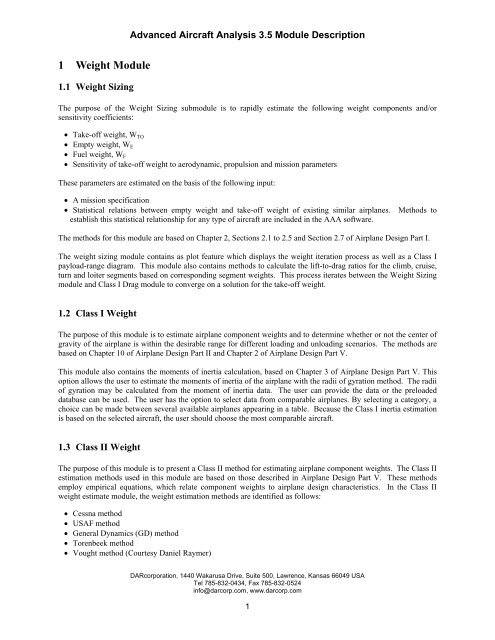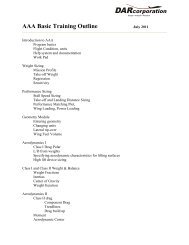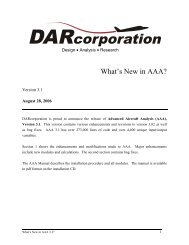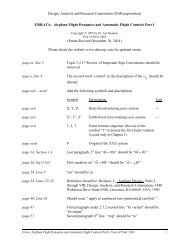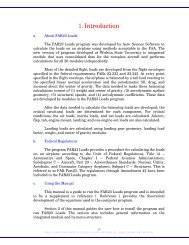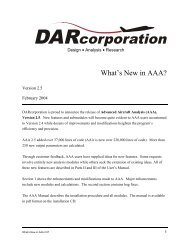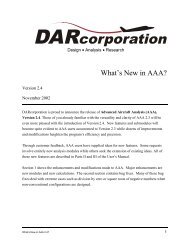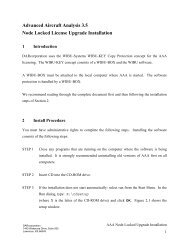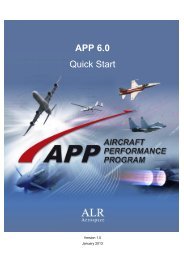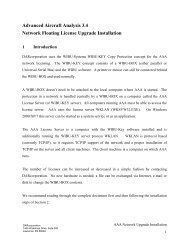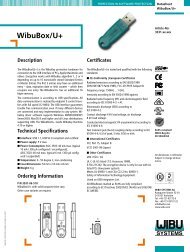AAA Modules Descriptions - DARcorporation
AAA Modules Descriptions - DARcorporation
AAA Modules Descriptions - DARcorporation
You also want an ePaper? Increase the reach of your titles
YUMPU automatically turns print PDFs into web optimized ePapers that Google loves.
Advanced Aircraft Analysis 3.5 Module Description1 Weight Module1.1 Weight SizingThe purpose of the Weight Sizing submodule is to rapidly estimate the following weight components and/orsensitivity coefficients: Take-off weight, W TO Empty weight, W E Fuel weight, W F Sensitivity of take-off weight to aerodynamic, propulsion and mission parametersThese parameters are estimated on the basis of the following input: A mission specification Statistical relations between empty weight and take-off weight of existing similar airplanes. Methods toestablish this statistical relationship for any type of aircraft are included in the <strong>AAA</strong> software.The methods for this module are based on Chapter 2, Sections 2.1 to 2.5 and Section 2.7 of Airplane Design Part I.The weight sizing module contains as plot feature which displays the weight iteration process as well as a Class Ipayload-range diagram. This module also contains methods to calculate the lift-to-drag ratios for the climb, cruise,turn and loiter segments based on corresponding segment weights. This process iterates between the Weight Sizingmodule and Class I Drag module to converge on a solution for the take-off weight.1.2 Class I WeightThe purpose of this module is to estimate airplane component weights and to determine whether or not the center ofgravity of the airplane is within the desirable range for different loading and unloading scenarios. The methods arebased on Chapter 10 of Airplane Design Part II and Chapter 2 of Airplane Design Part V.This module also contains the moments of inertia calculation, based on Chapter 3 of Airplane Design Part V. Thisoption allows the user to estimate the moments of inertia of the airplane with the radii of gyration method. The radiiof gyration may be calculated from the moment of inertia data. The user can provide the data or the preloadeddatabase can be used. The user has the option to select data from comparable airplanes. By selecting a category, achoice can be made between several available airplanes appearing in a table. Because the Class I inertia estimationis based on the selected aircraft, the user should choose the most comparable aircraft.1.3 Class II WeightThe purpose of this module is to present a Class II method for estimating airplane component weights. The Class IIestimation methods used in this module are based on those described in Airplane Design Part V. These methodsemploy empirical equations, which relate component weights to airplane design characteristics. In the Class IIweight estimate module, the weight estimation methods are identified as follows: Cessna method USAF method General Dynamics (GD) method Torenbeek method Vought method (Courtesy Daniel Raymer)<strong>DARcorporation</strong>, 1440 Wakarusa Drive, Suite 500, Lawrence, Kansas 66049 USATel 785-832-0434, Fax 785-832-0524info@darcorp.com, www.darcorp.com1
Advanced Aircraft Analysis 3.5 Module DescriptionBecause airplane component weight modeling in the software is a function of take-off weight, the Class II weightestimation module includes a weight iteration calculation which iterates between the take-off weights andcomponent weights to converge on a solution.Component Center of Gravity option allows the user to calculate the airplane center of gravity by entering weightcomponents and their locations in a preformatted table. Tables are available for structure weight, fixed equipmentweight, powerplant weight and total weight. Center of gravity of wing, canard, horizontal tail, vertical tail, V-tail,fuselage, tailbooms, nacelles, stores, floats, pylons, landing gear, ventral fins, propellers and engines are calculated.These are based on geometry of the components and on the methods described in Chapter 8 of Airplane DesignPart V.Detailed center of gravity calculations based on empty weight and various loading scenarios are included in thesoftware. These calculations include the determination of the most forward and most aft center of gravity based onthe minimum and maximum weights of passengers, fuel, baggage, cargo etc. and the total center of gravity based ona specific loading scenario. The software includes the option to plot the C.G. envelope based on all possible loadingscenarios. The plot feature can also be used to plot the empty weight C.G. along with the empty weightcomponent’s C.G. together with a side view of the airplane.Detailed moments of inertia for the entire aircraft based on component weights and component inertias can becalculated as well as the component moments of inertia of lifting surfaces (wings, canards, horizontal tails, verticaltails etc.) and bodies (fuselage, nacelles, floats, tailbooms etc.).2 Aerodynamics Module2.1 LiftThe Lift submodule can be used for estimating the lifting characteristics of airplane lifting surfaces and high liftdevices. Maximum lift coefficients for airfoils and wing, horizontal tail, vertical tail, V-tail and canard arecalculated. The increase in the maximum lift coefficients caused by multiple high lift device segments is calculated.The user can define multiple unique segments of high lift devices on the wing. The user can select from thefollowing list of high lift devices.SlatsKrueger FlapsDrooped AileronsPlain FlapsSplit FlapsSingle-Slotted FlapsType I Double-Slotted FlapsType II Double-Slotted FlapsFowler FlapsTriple-Slotted FlapsThe size of the trailing edge flap segment needed to meet the desired maximum lift coefficient for take-off andlanding conditions can be calculated. The plotting feature can be used to plot the high lift device maximum liftcoefficient as a function of flap deflection and flap chord ratio. The methods are based on Chapter 7 of AirplaneDesign Part II. The methodology used to determine the lifting surface spanwise lift distribution is based on liftingline theory.<strong>DARcorporation</strong>, 1440 Wakarusa Drive, Suite 500, Lawrence, Kansas 66049 USATel 785-832-0434, Fax 785-832-0524info@darcorp.com, www.darcorp.com2
Advanced Aircraft Analysis 3.5 Module DescriptionLift as function of angle of attack, elevator (canardvator, ruddervator) and horizontal tail (canard, V-tail) incidencecan be calculated.The lift coefficient at zero-angle-of-attack can be used to determine the lift coefficients, downwash angle andupwash angle at zero airplane angle of attack and the zero lift angle of attack. This module includes flap effects.The methods are described in Chapter 8 of Airplane Design Part VI.Further, the effect of body width on lift curve slope may also be calculated.2.2 Class I Drag PolarsThe Class I Drag submodule can be used for a first estimate of the airplane drag. The Class I Drag module has thefollowing seven options: flaps in take-off configuration with gear down flaps in take-off configuration with gear up no flap deflection and gear up flaps in landing configuration with gear up flaps in landing configuration with gear down one engine inoperative configuration current airplane flight conditionThe program will check to see if the airplane has retractable or fixed landing gear. All drag polars may be displayedat once: Gear Up, Gear Down, Flaps Up, Flaps Down, One Engine Inoperative and Current Condition. Themethodology used to calculate the drag polar can be found in Chapter 3 of Airplane Design Part I. The Class I Dragmodule relates the total airplane lift coefficient to the total airplane drag coefficient by a parabolic drag polarequation.2.3 Class II Drag PolarsThe purpose of the Class II Drag submodule is to supply a Class II method for predicting drag polars of airplanesduring the preliminary design phase. A detailed drag polar can be calculated for the subsonic, transonic andsupersonic flow regimes. The following drag calculations can be performed: wing drag coefficient trailing edge flap drag coefficient trim drag coefficient horizontal tail drag coefficient leading edge flap drag coefficient spoiler drag coefficient vertical tail drag coefficient gear drag coefficient miscellaneous drag coefficient V-tail drag coefficient canopy drag coefficient pylon drag coefficient canard drag coefficient windshield drag coefficient drag coefficient due to windmilling fuselage drag coefficient floats drag coefficient total aircraft drag coefficients nacelle drag coefficient stores drag coefficientThe program will account for fuselage base area change as a function of inoperative engines. Changes in nacelledrag are also accounted for due to inoperative engines. Dihedral is accounted for in the wetted areas of liftingsurfaces.The methods are based on Chapter 4 of Airplane Design Part VI.The drag coefficient can be plotted as a function of lift coefficient, Mach number, flap deflection and as acomponent build-up. Drag can also be plotted as a function of angle-of-attack for an untrimmed airplane. The dragcan be approximated with a trendline.<strong>DARcorporation</strong>, 1440 Wakarusa Drive, Suite 500, Lawrence, Kansas 66049 USATel 785-832-0434, Fax 785-832-0524info@darcorp.com, www.darcorp.com3
Advanced Aircraft Analysis 3.5 Module Description2.4 Wind TunnelThe purpose of this module is to scale the wind tunnel zero-lift drag coefficients and stability & control derivativesto full scale with appropriate Mach number and Reynold’s number corrections.2.5 MomentThe Moment submodule calculates the spanwise moment distribution on the wing, horizontal tail, vertical tail andcanard. The ground effects on airplane moment are also determined. Methods are based on Airplane DesignPart VI.Moment as function of angle of attack, elevator (canardvator) and horizontal tail (canard) incidence can becalculated.This pitching moment at zero-angle-of-attack submodule can be used to determine the zero lift airplane pitchingmoment coefficients and pitching moment coefficients at zero airplane angle of attack. This module includes flapeffects. To account for each airplane component, the pitching moment coefficient components are calculatedseparately. The user can estimate the zero lift pitching moment coefficient, the effect of trailing and leading edgeflaps on lift and pitching moment coefficients. The methods are described in Chapter 8 of Airplane Design Part VI.2.6 Aerodynamic CenterThe Aerodynamic Center submodule can be used to calculate aerodynamic center locations of individual airplanecomponents and the aerodynamic center shift due to components. The aerodynamic center methods described arefound in Airplane Design Part VI.The aerodynamic center and shift can be calculated for the following components: fuselage V-tail stores wing canard tailbooms horizontal tail nacelles pylons vertical tail floats total airplane2.7 Power EffectsThe purpose of the Power Effects module is to calculate the effects of the operating propeller on aerodynamicproperties of the airplane. The effects of power are calculated for the following parameters: horizontal tail downwash angle V-tail downwash angle dynamic pressure ratio lift and pitching moment coefficients drag due to powerPower Effects can be applied to both single and multi-engine propeller driven aircraft.<strong>DARcorporation</strong>, 1440 Wakarusa Drive, Suite 500, Lawrence, Kansas 66049 USATel 785-832-0434, Fax 785-832-0524info@darcorp.com, www.darcorp.com4
Advanced Aircraft Analysis 3.5 Module Description2.8 Ground EffectsThe Ground Effects module predicts the change in wing-fuselage lift coefficient, pitching moment coefficient andhorizontal tail downwash angle due to the close proximity of the aircraft to the ground.2.9 Dynamic Pressure RatioThe Dynamic Pressure Ratio module allows the user to predict the horizontal tail, V-tail and vertical tail dynamicpressure ratio as a variation of angle of attack. The wake effects are also accounted for in these calculations.2.10 Deep Stall AnglesThe Deep Stall Angles module allows the user to estimate the possible onset of deep stall. The module calculatesthe flow separation angles from the wing leading and trailing edges that could possibly blanket the horizontal tail.3 Performance Module3.1 Performance SizingThe purpose of the Performance Sizing module is to allow for a rapid estimation of those airplane designparameters, which have a major impact on airplane performance. Airplanes are usually required to meetperformance objectives in different categories depending on the mission profile. Meeting these performanceobjectives normally results in the determination of a range of values for: wing loading (W/S) thrust loading (T/W) or power loading (W/P) airplane maximum lift coefficientsThe variables listed above are plotted in the form of a performance-matching plot. These plots depend on the typeof airplane, the applicable specification and the applicable regulation(s). With the help of such a plot, thecombination of the highest possible wing loading and the smallest possible thrust (or highest power) loading, whichmeets all performance requirements, can be determined. The methodology used for performance sizing can befound in Airplane Design Part I.3.2 Performance AnalysisThe purpose of the Analysis submodule is to provide the user with Class II analysis methods for predicting theperformance characteristics of an airplane. The methodology used to analyze the performance characteristics can befound in Chapter 5 of Airplane Design Part VII and Airplane Aerodynamics and Performance.The performance characteristics consists of : Stall speed Take-off distance Climb Cruise Dive and Descent Maneuver Glide Landing DistanceThe engine performance data such as thrust or power can be entered as function of speed.<strong>DARcorporation</strong>, 1440 Wakarusa Drive, Suite 500, Lawrence, Kansas 66049 USATel 785-832-0434, Fax 785-832-0524info@darcorp.com, www.darcorp.com5
Advanced Aircraft Analysis 3.5 Module Description4 Geometry ModuleThe purpose of the geometry module is to help the user define the geometry of the fuselage, tailbooms, floats, stores,nacelles, pylons, wing, horizontal tail, vertical tail, V-tail and canard and calculate related parameters. Themethodology used to calculate the airplane component geometries is described in Airplane Design Part II. Twodimensionalgeometry can be defined for straight and cranked lifting surfaces. For cranked lifting surfaces, anequivalent lifting surface defined by the fixing the tip or the mean geometric chord is generated. The fuel volume inthe wing is calculated using Class I and Class II methods and accounts for fuel in cranked wings. For the horizontaltail, vertical tail, V-tail and canard the volume coefficient can be calculated. The control surfaces along with thecorresponding lifting surfaces can be plotted. The chord length, airfoil thickness ratio and twist of any liftingsurface at a specified spanwise station can be determined.The fuselage module shows all cross-sections of the fuselage and is used to determine fuselage camber, inclinationangles of each segment and cross-sectional area distribution.A three-view of the aircraft can be shown in the three-view module of the software. The airplane geometry can beexported to CAD programs that use AeroPack (Shark FX). From SharkFX software, the geometry can be exportedusing several formats like STP, STL, DWG, DXF etc. The software allows the user to scale all the geometricparameters. For example, the geometric parameters can be scaled down to generate a smaller sized model suitablefor wind tunnel testing.The landing gear option allows the user to calculate the lateral angle between the airplane center of gravity and thelanding gear. This angle is useful in determining the risk of lateral tip-over on the ground.5 Propulsion ModuleIn this module the installed power and thrust of airplanes can be calculated. In addition to the installed power/thrustestimation, this module also provides options for inlet and nozzle sizing, estimation of inlet pressure recovery.Power extraction is also accounted for. Calculations in this module are based on the methodologies outlined inChapter 6 of Airplane Design Part VI.The methods are valid for piston engines, jet engines, turboprop and propfan engines. Installed thrust or power canbe calculated from uninstalled engine performance.6 Stability & Control Module6.1 Stability & Control DerivativesThe purpose of the Derivatives submodule is to compute the non-dimensional aerodynamic coefficients stability andcontrol derivatives for a rigid airplane in a given flight condition (i.e., for a given weight, altitude, speed andC.G. location). The derivatives module consists of longitudinal stability derivatives, lateral-directional stabilityderivatives, longitudinal control derivatives and lateral-directional control derivatives. The derivatives can becalculated for tail aft, canard and three-surface configurations.For longitudinal stability derivatives the following options are available: steady state lift, drag, moment and thrust coefficients speed derivatives<strong>DARcorporation</strong>, 1440 Wakarusa Drive, Suite 500, Lawrence, Kansas 66049 USATel 785-832-0434, Fax 785-832-0524info@darcorp.com, www.darcorp.com6
Advanced Aircraft Analysis 3.5 Module Description angle-of-attack derivatives rate of angle-of-attack derivatives pitch rate derivativesFor lateral-directional stability derivatives the following options are available: angle-of-sideslip derivatives rate of angle-of-sideslip derivatives roll rate derivatives yaw rate derivativesFor longitudinal control derivatives the following options are available: stabilizer control derivatives elevator control derivatives ruddervator control derivatives canard control derivatives canardvator control derivatives elevon control derivatives elevator tab control derivatives ruddervator tab control derivatives canardvator tab control derivatives elevon tab-control derivativesFor lateral-directional control derivatives the following options are available: aileron derivatives spoiler derivatives differential stabilizer derivatives rudder derivatives rudder tab derivatives aileron tab derivatives6.2 Hinge Moment DerivativesThe hinge moment submodule is used to determine the hinge moment coefficient derivatives of the elevator, rudder,aileron, canardvator, elevator tab, rudder tab, aileron tab and canardvator tab. The control surfaces can haveunshielded, fully shielded and partially shielded horn balances. The methodology for the hinge moment calculationsis found in Airplane Design Part VI.6.3 Class I Stability and Control/Empennage Sizing AnalysisThe methodology used to analyze the Stability and Control characteristics can be found in Chapter 11 of AirplaneDesign Part II. This module includes longitudinal stability and empennage sizing, directional stability andempennage sizing and minimum control speed with one engine inoperative stability/empennage sizing.Inputs are simplified and choice is given between geometric volume coefficient or volume coefficient based on C.G.and A.C.<strong>DARcorporation</strong>, 1440 Wakarusa Drive, Suite 500, Lawrence, Kansas 66049 USATel 785-832-0434, Fax 785-832-0524info@darcorp.com, www.darcorp.com7
Advanced Aircraft Analysis 3.5 Module Description6.4 Class II Stability and Control/Empennage Sizing AnalysisThe methodology used to analyze the longitudinal and lateral-directional trim characteristics can be found inChapter 5 of Flight Dynamics Part I.The Class II methods consist of trim diagram, longitudinal trim and lateral-directional trim. The elevator stick (orcontrol wheel) forces, aileron stick (or control wheel) forces and rudder pedal forces can be calculated. The trimdiagram determines control deflections and angles of attack for different center of gravity locations to trim theairplane longitudinally. Trim diagrams include propeller power effects.Other important stability and control characteristics such as take-off rotation and a variety of dynamic stabilityconsiderations are calculated that are not covered by the Class I method.Effect of wing location variation on stability and center of gravity range is analyzed and plotted.7 Dynamics Module7.1 DynamicsThe purpose of the dynamics module is to help the user analyze the open loop dynamic characteristics of theairplane in a given flight condition. The methodology used to analyze open loop dynamic characteristics can befound in Airplane Flight Dynamics Part I.Dynamics is divided into estimation of the longitudinal and lateral-directional dynamic characteristics. Airplanetransfer functions are determined. Flying qualities are checked against civil and military requirements. The effectof roll-pitch yaw coupling effect on the dynamic analysis is also determined. Sensitivity of various stability andcontrol derivatives on flying qualities is also established. Phugoid and short period are determined. Spiral, Dutchroll and roll performance are investigated.The Routh-Hurwitz stability requirements are calculated.7.2 ControlThe purpose of the Control module is to help the user analyze single and double loop feedback control systems ofthe airplane. If the open loop dynamic characteristics of the airplane are known, root locus analyses may beperformed in the S-plane. The control analysis submodule can also be used to analyze a system open loop transferfunction in the frequency domain (Bode diagram). The methodology used to analyze feedback control systems canbe found in Airplane Flight Dynamics Part II.The transfer functions can be selected from the standard airplane transfer functions or defined by the user. If thelongitudinal and lateral-directional stability derivatives of the airplane are known, the user may use the Dynamicsmodule prior to using the Control analysis module to generate the longitudinal and lateral-directional dynamictransfer functions of the airplane. These transfer functions are transferred into the Control analysis module and canonly be generated in the Dynamics module.The transfer functions are: Speed-to-Elevator Angle-of-Attack-to-V-Tail Pitch-Angle-to-Canard Angle-of-Attack-to-Elevator Pitch-Angle-to-V-Tail Angle-of-Attack-to-Canardvator Pitch-Angle-to-Elevator Speed-to-Elevon Human Pilot<strong>DARcorporation</strong>, 1440 Wakarusa Drive, Suite 500, Lawrence, Kansas 66049 USATel 785-832-0434, Fax 785-832-0524info@darcorp.com, www.darcorp.com8
Advanced Aircraft Analysis 3.5 Module Description Speed-to-Ruddervator Angle-of-Attack-to-Elevon Sideslip-Angle-to-Aileron Angle-of-Attack-to- Ruddervator Pitch-Angle-to-Elevon Bank-Angle-to-Aileron Pitch-Angle-to- Ruddervator Speed-to-Canardvator Heading-Angle-to-Aileron Speed-to-Stabilizer Angle-of-Attack-to-Canardvator Sideslip-Angle-to-Rudder Angle-of-Attack-to-Stabilizer Pitch-Angle-to-Canardvator Bank-Angle-to-Rudder Pitch-Angle-to-Stabilizer Speed-to-Canard Heading-Angle-to-Rudder Speed-to-V-Tail Angle-of-Attack-to-Canard Defined by the userThe following control systems can be analyzed: single loop feedback double loop control systems with the inner loop gain in the forward path double loop control systems with the inner loop gain in the feedback path gyro tilt angle effectThe human pilot calculation can be used to estimate a human pilot transfer function for use in the open loop controlsystem analysis. The human pilot module can be used to model pilots of differing abilities, reaction times andphysical fitness. This module can even be used to show the dangers of a drunken pilot in the loop. Themethodology used to analyze a human pilot transfer function can be found in Chapter 10 of Airplane FlightDynamics Part II.8 Loads ModuleThe purpose of this module is to estimate loads placed on airplane components and to determine importantinformation for structural design and sizing. The Loads module consists of two submodules: V-n Diagram andStructural Loads. The purpose of the V-n Diagram submodule is to determine load factors and their correspondingspeeds. The purpose of the Structural Loads submodule is to calculate the internal forces and moments in thestructural components of an airplane. Use of the Loads module options will be described in the following sections.8.1 V-n DiagramIn this submodule, velocity vs. load factor (V-n) diagrams can be constructed for the following types of airplanes:FAR 23 certified, FAR 25 certified and MIL-A-8861(ASG) certified airplanes.8.2 Structural LoadsIn this submodule the total internal loads for each structural component can be calculated in any combination thatthe user desires.The following options are available to calculate the loads acting on a structural component: structural loads on the fuselage structural loads on the wing structural loads on the horizontal tail structural loads on the canard structural loads on the vertical tail estimation of the accelerations and rates acting on the airplane. Before the total internal loads for any structuralcomponent can be calculated, the linear accelerations, angular accelerations and angular rates must becalculated using this option<strong>DARcorporation</strong>, 1440 Wakarusa Drive, Suite 500, Lawrence, Kansas 66049 USATel 785-832-0434, Fax 785-832-0524info@darcorp.com, www.darcorp.com9
Advanced Aircraft Analysis 3.5 Module Description9 Structures Module9.1 Class I SizingThe purpose of this module is to estimate the size and weight of the structural components. This is done usingmaterial properties and the results of the calculation of the total internal loads for the component from the loadsmodule.9.2 MaterialsIn this submodule material properties that are not listed in the available materials table may be added and have theircharacteristics defined. These materials will be added to the user defined category of the available materials table.10 Cost Analysis ModuleThe purpose of this module is to estimate various costs of airplane design programs. The estimation methods arepresented in such a manner that they can be applied to civil and military airplanes of all types. The cost escalationfactor (CEF) used in this module accounts for inflation. The various cost definitions and cost estimation methodsused for this module are as discussed in Chapter 1 through 7 of Airplane Design Part VIII.After invoking the cost module, seven options are displayed: AMPR Weight R.D.T.E. Cost Prototype Cost Acquisition Cost Operating Cost (military) Operating Cost (civil) Life Cycle Cost Price DataFor estimation of the Aeronautical Manufacturers Planning Report (AMPR) weight.This weight parameter is needed for estimation of the various costs in an airplaneprogram.For estimation of the research, development, test and evaluation cost.For estimation of the cost of development, manufacturing and flight testing of theprototypes. This submodule is to be used only for those airplane programs that arenot intended for eventual production.For estimation of the manufacturing and acquisition costs. The difference betweenthese costs is the profit made by the manufacturer.For estimation of the military airplane operating costs.For estimation of the civil airplane operating costs.For estimation of the life cycle cost of an airplane program. The life cycle cost isdefined as the sum of R.D.T.E. cost, acquisition cost, operating cost and disposalcostFor estimation of the engine price, propeller price and airplane price as well as arapid method for estimating prices of future designs.11 AtmosphereThe purpose of the Atmosphere module is to calculate the properties of the standard atmosphere at a given altitudeand temperature offset. Air density, pressure, temperature, speed of sound and acceleration of gravity are calculatedas a function of altitude. For a given speed the Mach number is calculated.<strong>DARcorporation</strong>, 1440 Wakarusa Drive, Suite 500, Lawrence, Kansas 66049 USATel 785-832-0434, Fax 785-832-0524info@darcorp.com, www.darcorp.com10
Advanced Aircraft Analysis 3.5 Module Description12 Flight ConditionThe purpose of the Flight Condition window is to set and define each flight condition to be included in the analysis.An airplane project can have one or more flight conditions defined. All parameters depending on speed, weight, flapdeflection and center of gravity can be stored separately per flight condition. Flight conditions can be edited,moved, copied and deleted from the project.<strong>DARcorporation</strong>, 1440 Wakarusa Drive, Suite 500, Lawrence, Kansas 66049 USATel 785-832-0434, Fax 785-832-0524info@darcorp.com, www.darcorp.com11


